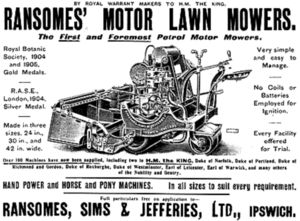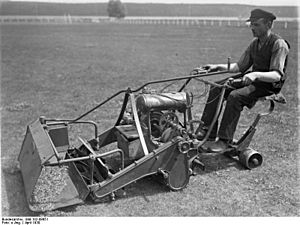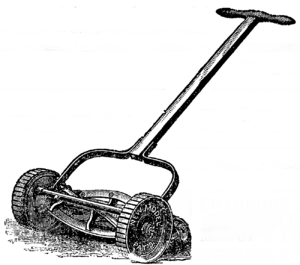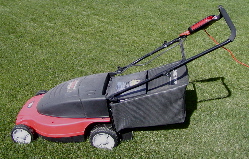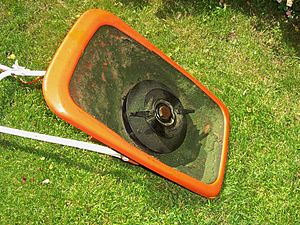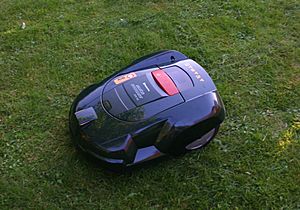Lawn mower facts for kids
A lawn mower (or lawnmower) is a machine that uses blades to cut a lawn. There are different types of lawn mowers. The smallest are pushed by a human, they are good for small lawns and gardens. Ride-on mowers are good for larger lawns. The largest are pulled behind a tractor, they are made for grass at places like golf courses and parks. Always wear safety equipment while working with these machines.
A lawn mower functions by spinning either a thin blade, or a small piece of cable, to cause lacerations on the stems of grass & other plants. Severing the plant and reducing the height of the plant to a more pleasing appearance.
Contents
History
Cylinder mowers
The first lawn mower was invented by Edwin Budding in 1827 in Thrupp, just outside Stroud, in Gloucestershire. Budding's mower was designed primarily to cut the lawn on sports grounds and expensive gardens, as a superior alternative to the scythe, and was patented in 1830. It took ten more years and further innovations to create a machine that could be worked by animals, and sixty years before a steam-powered lawn mower was built. In an agreement between John Ferrabee and Edwin Budding dated May 18, 1830, Ferrabee paid the costs of development, obtained letters of patent and acquired rights to manufacture, sell and license other manufacturers in the production of lawn mowers.
Thomas Green produced the first chain-driven mower in 1859. Manufacture of lawn mowers began in the 1860s. By 1862, Farrabee's company was making eight models in various roller sizes. He manufactured over 5000 machines until production ceased in 1863. In 1870, Elwood McGuire of Richmond, Indiana designed a human-pushed lawn mower, which was very lightweight and a commercial success. John Burr patented an improved rotary-blade lawn mower in 1899, with the wheel placement altered for better performance. Amariah Hills went on to found the Archimedean Lawn Mower Co. in 1871. Around 1900, one of the best known English machines was the Ransomes' Automaton, available in chain- or gear-driven models. JP Engineering of Leicester, founded after World War I, produced a range of very popular chain driven mowers. About this time, an operator could ride behind animals that pulled the large machines. These were the first riding mowers.
The rise in popularity of lawn sports helped prompt the spread of the invention. Lawn mowers became a more efficient alternative to the scythe and domesticated grazing animals. James Sumner of Lancashire patented the first steam-powered lawn mower in 1893. His machine burned petrol and/or kerosene as fuel. After numerous advances, the machines were sold by the Stott Fertilizer and Insecticide Company of Manchester and later, the Sumner's took over sales. The company they controlled was called the Leyland Steam Motor Company. Numerous manufacturers entered the field with gasoline-driven mowers after the turn of the century. The first grass boxes were flat trays but took their present shape in the 1860s. The roller-drive lawn mower has changed very little since around 1930. Gang mowers, those with multiple sets of blades, were built in the United States in 1919 by a Mister Worthington. His company was taken over by the Jacobsen Corporation, but his name is still cast on the frames of their gang units.
Rotary mowers
Rotary mowers were not developed until engines were small enough and powerful enough to run the blades at a high speed. Many people experimented with rotary blades in the late 1920s and early 1930s, and Power Specialties Ltd. introduced a gasoline-powered rotary mower. One company that produced rotary mowers commercially was the Victa company, starting in 1952: these mowers were lighter and easier to use than the mowers that came before.
Types of lawn mowers
By rotation
Cylinder (UK) or Reel (US) mowers
The cylinder mower carries a fixed, horizontal cutting blade at the desired height of cut. Over this is a fast-spinning reel of blades which force the grass past the cutting bar. Each blade in the blade cylinder forms a helix around the reel axis, and the set of spinning blades describes a cylinder.
Of all the mowers, a properly adjusted cylinder mower makes the cleanest cut of the grass, and this allows the grass to heal more quickly. The cutting action is often likened to that of scissors; however, it is not necessary for the blades of the spinning cylinder to contact the horizontal cutting bar. If the gap between the blades is less than the thickness of the grass, a clean cut can still be made.
There are many variants of the cylinder mower. Push mowers (illustrated) have no motor and are used on small lawns. As the mower is pushed along, the wheels drive gears which rapidly spin the reel. Typical cutting widths are 12 to 20 inches (510 mm).
The basic push mower mechanism is also used in gangs towed behind a tractor. The individual mowers are arranged in a vee behind the tractor with each mower's track slightly overlapping that of the mower in front of it. Gang mowers are used over large areas of turf such as sports fields or parks.
A gasoline engine or electric motor can be added to a reel mower to power the reel, the wheels, or both. A typical arrangement for residential lawns has the motor spinning the reel while the operator pushes the mower along. The electric models can be corded or cordless. Some variants have only 3 blades in a reel spinning at great speed, and these models can cut grass which has grown too long for ordinary push mowers. One type of reel mower, now largely obsolete, was a powered version of the traditional side wheel push mower and was used on residential lawns. An internal combustion engine sat atop the reel housing and drove the wheels, usually though a belt. The wheels in turn drove the reel, as in the push mower.
Greens (roller) mowers are used for the precision cutting of golf greens. The reel is followed by a large roller which smooths the freshly cut lawn and minimizes wheel marks. Due to the weight, the engine also propels the mower. Much smaller and lighter variants of the roller mower are sometimes used for small patches of ornamental lawns around flower beds, and these have no engine.
Riding reel mowers are also produced. Typically, the cutting reels are ahead of the vehicle's main wheels, so that the grass can be cut before the wheels push the grass over onto the ground. The reels are often hydraulically powered.
Rotary mowers
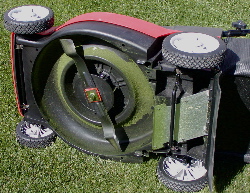
A rotary mower rotates about a vertical axis.
By energy source
Gasoline (petrol)
Most rotary push mowers are powered by internal combustion engines. Such engines can be either two-stroke or four-stroke cycle engines, running on gasoline (petrol) or other liquid fuels. Internal combustion engines used with lawn mowers normally have only one cylinder. Power generally ranges from two to seven horsepower (1.5 to 6.75 kW). The engines are usually carbureted and require a manual pull crank to start them, although electric starting is offered on some models. Some mowers have a throttle control on the handlebar with which the operator can adjust the engine speed. Other mowers have a fixed, pre-set engine speed. Gasoline mowers have the advantages over electric mowers of greater power and distance range. However, they create substantial pollution and their engines require periodic maintenance such as cleaning or replacement of the spark plug and air filter.
Electric
Electric mowers are further subdivided into corded and cordless electric models. Both are relatively quiet, typically producing less than 75 decibels, while a gasoline lawn mower can be as loud as 95 decibels or more. This kind of mower can also be safer to operate as they come equipped with a dead man's switch to immediately stop the motor when it is not being operated.
Corded electric
Corded electric mowers are limited in range by their trailing power cord, which may limit their use with lawns extending outward more than 100-150 feet from the nearest available power outlet. There is the additional hazard with these machines of accidentally mowing over the power cable, which stops the mower and may put users at risk of receiving a dangerous electric shock. Installing a residual-current device (GFCI) on the outlet may reduce the shock risk. On the United States market as of summer 2008, a corded electric mower from a respectable manufacturer costs about the same as an entry-level internal-combustion mower ($150–200), with significantly higher reliability, significantly lower cost of ownership, and a significantly reduced carbon footprint.
Cordless electric
Cordless electric mowers are powered by a variable number (typically 1-4) of 12 volt rechargeable batteries. Typically more batteries mean more run time and/or power. Batteries can be in the interior of the lawn mower or on the outside. If on the outside the drained batteries can be replaced with recharged batteries. Cordless mowers have the maneuverability of a gasoline powered mower and the environmental friendliness of a corded electric but are more expensive and come in fewer models (particularly self-propelling) than either.
Other
Hover mowers are powered rotary push lawn mowers that use a turbine above the spinning blades to drive air downwards, thereby creating an air cushion that lifts the mower above the ground. The operator can then easily move the mower as it floats over the grass. Hover mowers are necessarily light in order to achieve the air cushion and typically have plastic bodies with an electric motor. The most significant downside, however, is the cumbersome usability in rough terrain or on the edges of lawns, as the lifting air-cushion is destroyed by wide gaps between the chassis and the ground.
A robotic mower is contained by a border wire around the lawn that defines the area to be mowed. The robot uses this wire to locate the boundary of the area to be trimmed and in some cases to locate a recharging dock. Robotic mowers are capable of maintaining up to 5 acres (20,000 m2) of grass. Robotic lawn mowers are increasingly sophisticated, are usually self-docking and contain rain sensors, nearly eliminating human interaction for mowing grass. Multiple robotic mowers can be used to mow an even larger area.
Riding mowers are a popular alternative for large lawns. The operator is provided with a seat and controls on the mower and literally 'rides' on the machine. Most use the horizontal rotating blade system, though usually with multiple blades.
A common form of ride-on mower is the lawn tractor. These are usually designed to resemble a small agricultural tractor, with the cutting deck mounted amidships between the front and rear axles.
The drives for these mowers are in several categories. The most common transmission for tractors is a manual transmission. The second most common transmission type is a form of continuously variable transmission called the hydrostatic transmission. These transmissions take several forms, from pumps driving separate motors, which may incorporate a gear reduction, to fully integrated units containing a pump, motor and gear reduction. Hydrostatic transmissions are more expensive than mechanical transmissions but they are easier to use and can transmit greater torque to the wheels as compared to a typical mechanical transmission. The least common drive type, and the most expensive, is electric.
There have been a number of attempts to replace hydrostatic transmissions with a lower cost alternative, but these attempts, which include variable belt types (e.g., MTD's Auto Drive) and toroidal, have various performance or perception problems that has caused their market life to be short or their market penetration to be limited.
Riding lawnmowers can often mount other devices such as rototillers, snowplows, snowblowers, yard vacuums, occasionally even front buckets or fork-lift tines.
The deck of a rotary mower is typically made of steel. Lighter steel is used on less expensive models, and heavier steel on more expensive models for durability. Other deck materials include aluminum, which does not rust and is a staple of higher priced mowers, and hard composite plastic, which does not rust and is lighter and less expensive than aluminum. Electric mowers typically have a plastic deck.
Riding mowers typically have an opening in the side or rear of the housing where the cut grass is expelled. Some have a grass catcher attachment at the opening to bag the grass clippings. Special mulching blades are available for rotary mowers. The blade is designed to keep the clippings circulating underneath the mower until the clippings are chopped quite small. Other designs have twin blades to mulch the clippings to small pieces. This function has the advantages of forgoing the additional work collecting and disposing grass clippings while reducing lawn waste in such a way that also creates convenient compost for the lawn, forgoing the expense of fertilizer.
Mower manufacturers market their mowers as side discharge, 2-in-1, meaning bagging and mulching or side discharging and mulching, and 3-in-1, meaning bagging, mulching, and side discharge. Most 2-in-1 bagging and mulching mowers require a separate attachment to discharge grass onto the lawn. Some side discharge mower manufacturers also sell separate "mulching plates" that will cover the opening on the side discharge mower and, in combination with the proper blades, will convert the mower to a mulching mower. These conversions are impractical when compared with 2- or 3-in-1 mowers which can be converted in the field in seconds. There are two types of bagging mowers. A rear bag mower features an opening on the back of the mower through which the grass is expelled into the bag. Hi-vac mowers have a tunnel that extends from the side discharge to the bag. Hi-vac is also the type of grass collection used on riding lawn mowers and lawn tractors and is considered more efficient. Mulching and bagging mowers are not well suited to long grass or thick weeds.
Images for kids
-
Noise level from a lawn mower measured using the NIOSH Sound Level Meter app
-
An Ursus tractor-pulled mower.
See also
 In Spanish: Cortacésped para niños
In Spanish: Cortacésped para niños



